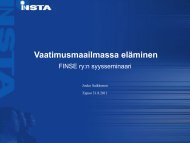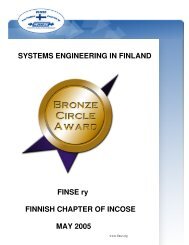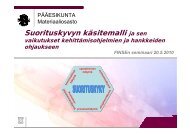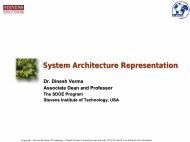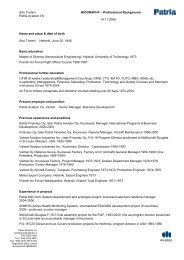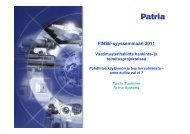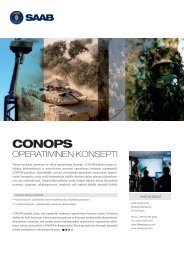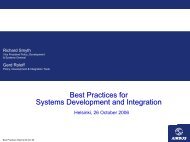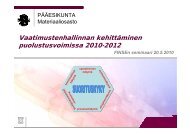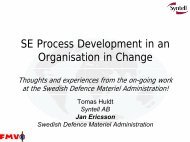Hannu Snellman.pdf - FINSE
Hannu Snellman.pdf - FINSE
Hannu Snellman.pdf - FINSE
You also want an ePaper? Increase the reach of your titles
YUMPU automatically turns print PDFs into web optimized ePapers that Google loves.
<strong>FINSE</strong> ry symposiums<br />
“System/Product Lifecycle<br />
Management”<br />
Nokia Research Center, , Helsinki, FINLAND, 23rd October 2003<br />
Continuous assessment of selected<br />
suppliers using AWARD solution<br />
<strong>Hannu</strong> <strong>Snellman</strong> – Managing Director<br />
– MiddleWare Oy<br />
Copyright © Commerce Decisions Ltd 2001-2003<br />
CD: Magdalen Centre, Oxford Science Park, Oxford, OX4 4GA, UK<br />
+44 (0)1865 784350 www.commercedecisions.com<br />
MW: Business Center, Nihtikuja 3A, FIN-02630 Espoo, FINLAND<br />
+358 (0)9 270 68290 www.middleware.fi
AGENDA<br />
• Collaborative, efficient<br />
proposal evaluation<br />
• Objective frameworks for<br />
negotiation<br />
• Continuous assessment of<br />
suppliers<br />
• Functionality of AWARD<br />
solution to buyers and<br />
bidders<br />
Copyright © Commerce Decisions Ltd 2001-2003
Introducing Commerce Decisions<br />
• A technology company completely focussed on supporting buyers<br />
and bidders on complex procurements<br />
• Our technology is supporting projects worth over<br />
$20 billion<br />
• Head Office in<br />
Oxford Science Park UK<br />
• Operations in UK, France<br />
and USA<br />
• MiddleWare is Nordic Distributor<br />
• Extensive usage by Defence,<br />
Local Government,<br />
Healthcare, PFI/PPP<br />
• UK MoD Preferred<br />
Assessment Tool<br />
Copyright © Commerce Decisions Ltd 2001-2003
The Market – Contract Lifecycle Management<br />
Gartner: Largely ignored historically , but worth $20 billion by 2007<br />
Buy Side<br />
Create<br />
Request<br />
For Proposal<br />
Conduct Bid<br />
Assessment<br />
Select<br />
Preferred<br />
Supplier<br />
Negotiate<br />
Contract<br />
Award<br />
Contract<br />
Continuous<br />
Performance<br />
Assessment<br />
Acceptance<br />
Review<br />
Request for<br />
Proposal<br />
Develop Bid<br />
Document<br />
Red Team<br />
Review<br />
Negotiate<br />
Contract<br />
Sign<br />
Contract<br />
Deliver<br />
Against<br />
Contract<br />
Hand Over<br />
To Client<br />
Sell Side<br />
Copyright © Commerce Decisions Ltd 2001-2003
The Characteristics of Complex Procurements<br />
• Low volume, bespoke<br />
• Multiple selection criteria<br />
• Multiple stakeholders<br />
• Huge paper based document<br />
sets<br />
• Competition important<br />
• Intangible products<br />
• May be product or process<br />
Copyright © Commerce Decisions Ltd 2001-2003
Achieving Value for Money on Complex Procurements<br />
• Best Value is important, not just best price<br />
• To achieve value for money we need to:<br />
Understand what we mean by value for money in the context of<br />
a particular procurement<br />
Measure the value for money offered in supplier proposals<br />
Optimise value for money through informed and objective<br />
negotiation<br />
Validate we are getting value for money as a contract<br />
progresses<br />
• Commerce Decisions has helped our customers<br />
achieve this on complex procurements worth over<br />
€20 billion.<br />
Copyright © Commerce Decisions Ltd 2001-2003
Real experiences of proposal evaluation and negotiation<br />
• No audit trail - indefensible decisions<br />
• Cost of wrong decisions very high<br />
• Distributed teams – different departments and locations<br />
• Costly and time consuming<br />
• Subjective decisions<br />
• Difficult to manage information – huge information sets<br />
• Ad-hoc competition and negotiation processes<br />
• Lack of process<br />
• No organisational learning<br />
• Few supporting tools – reliance on MS office tools<br />
Copyright © Commerce Decisions Ltd 2001-2003
How can we measure and optimise value for money<br />
• Need a framework we can use to model and measure<br />
VfM<br />
• This framework also needs to provide process<br />
efficiencies<br />
• Basic concepts of the frame work<br />
• Criteria<br />
• Weighting<br />
• Measurement<br />
• Score Types<br />
• Analysis<br />
• Time<br />
Copyright © Commerce Decisions Ltd 2001-2003
What are criteria?<br />
• Criteria are the means by which we rate the relative<br />
merits of differing alternatives.<br />
• Related to requirements, but not the same thing.<br />
• Independent:<br />
• colour of the car;<br />
• acceleration of the car.<br />
• Complementary:<br />
• acceleration of the car;<br />
• power of the engine.<br />
• Contradictory:<br />
• power of the engine;<br />
• fuel efficiency.<br />
Copyright © Commerce Decisions Ltd 2001-2003
How do we organise criteria?<br />
• Flat list:<br />
• difficult to spot gaps, duplication and<br />
inconsistencies;<br />
• almost impossible to decide relative<br />
importance;<br />
• difficult to summarise and abstract;<br />
• difficult to manage allocation to<br />
different people.<br />
Badge / brand of car<br />
Colour<br />
Acceleration<br />
Power of the engine<br />
Type of engine<br />
Fuel efficiency<br />
Type of fuel<br />
Saloon / estate / coupe / open-top<br />
Styling<br />
Comfort of seating position<br />
Cruise control<br />
Electric windows<br />
Clear instrumentation<br />
Ease of use of controls<br />
Gearbox configuration<br />
Roadholding ability<br />
Brake feel and efficiency<br />
Resale values<br />
Internal noise when driving on motorway<br />
Passengers airbags<br />
Electric mirrors<br />
Climate control<br />
Side impact protection<br />
How long has the model been available?<br />
Financial viability of the manufacturer<br />
Insurance group<br />
Tax group<br />
Feel and fit of interior<br />
Build quality<br />
Price<br />
Cost of routine servicing<br />
Service interval<br />
Cost of non-consumable spares<br />
Warrantee<br />
Local servicing<br />
Courtesy car available when in for repair<br />
Copyright © Commerce Decisions Ltd 2001-2003
What about a hierarchical list?<br />
• Hierarchical list:<br />
• similar elements grouped together, so easier to remove duplication<br />
and inconsistency;<br />
• logical structure helps identify gaps at each level of abstraction;<br />
• each layer of the hierarchy is a different level of abstraction;<br />
• the hierarchy provides a natural mechanism for allocating an area of<br />
responsibility to an individual.<br />
Overall<br />
Financial<br />
Technical<br />
Other<br />
Purchase<br />
cost<br />
Running<br />
cost<br />
Depreciation<br />
Performance Safety Comfort<br />
Make<br />
Local<br />
servicing<br />
Fuel Servicing Other<br />
Seats<br />
Climate Noise Space<br />
Warrantee Insurance Tax<br />
Front<br />
Back<br />
Copyright © Commerce Decisions Ltd 2001-2003
Weighting<br />
• We weight the criteria relative to each other.<br />
• It doesn’t matter what they add up to.<br />
• We can choose numbers and scales that<br />
are convenient to us.<br />
• However, in order to aggregate the<br />
weights up the tree we need to normalise them.<br />
• We simply re-calculate the weights so that the weights on the<br />
criteria under a single node add up to 100 (or any other number).<br />
• AWARD does this automatically.<br />
Front<br />
Seats<br />
Back<br />
6 4<br />
Comfort<br />
33<br />
Seats<br />
17 20<br />
Climate Noise Space<br />
30<br />
Front<br />
Back<br />
60 40<br />
Copyright © Commerce Decisions Ltd 2001-2003
Sensitivity<br />
• We are now able to calculate the weight that each<br />
individual criterion has overall.<br />
• Start at the top of the tree.<br />
• For each node criterion multiply the weights of all the criteria under<br />
it by the weight of the node criteria – then divide by 100 (assuming<br />
the criteria add up to 100).<br />
• Repeat for each level of the tree.<br />
• We call the result the “sensitivity” of the criterion.<br />
• AWARD does this automatically.<br />
Comfort<br />
33<br />
33<br />
Seats<br />
17 20 30<br />
17 20<br />
Climate Noise Space<br />
30<br />
Front<br />
Back<br />
60 40<br />
20<br />
13<br />
Copyright © Commerce Decisions Ltd 2001-2003
100<br />
80<br />
60<br />
40<br />
20<br />
0<br />
0 2 4 6 8 10 12 14 16 18 20<br />
100<br />
80<br />
60<br />
40<br />
20<br />
0<br />
0 100 200 300 400 500 600 700 800<br />
100<br />
80<br />
60<br />
40<br />
20<br />
0<br />
0 2 4 6 8 10 12 14 16 18 20<br />
£ Thousands<br />
100<br />
80<br />
60<br />
40<br />
20<br />
0<br />
Lexus Jaguar Citroen Ford Skoda Mercedes Audi BMW<br />
Measurement functions<br />
• We map measurement functions to the criteria<br />
• We can use the same function to measure more than one criteria<br />
Overall<br />
Financial<br />
Technical<br />
Other<br />
Purchase<br />
cost<br />
Running<br />
cost<br />
Depreciation<br />
Performance Safety Comfort<br />
Make<br />
Local<br />
servicing<br />
Fuel Servicing Other<br />
Seats<br />
Climate Noise Space<br />
Warrantee Insurance Tax<br />
Front<br />
Back<br />
Desirability of make<br />
value<br />
Fuel consumption<br />
value<br />
Insurance cost<br />
value<br />
Purchase cost<br />
value<br />
litres / 100 km<br />
£ / annum<br />
Brand<br />
Copyright © Commerce Decisions Ltd 2001-2003
Score Types<br />
• For each criterion we record four scores.<br />
• Face value (what we are being told by the bidder)<br />
• Likely value (what we think is the most likely outcome)<br />
• Optimistic case (what we think the best case scenario is)<br />
• Pessimistic case (what we think the worst case scenario is)<br />
• The four scores can be the same.<br />
Fuel consumption<br />
value<br />
100<br />
80<br />
60<br />
40<br />
F<br />
O<br />
L<br />
P<br />
value<br />
100<br />
80<br />
60<br />
40<br />
L<br />
Fuel consumption<br />
20<br />
20<br />
0<br />
0 2 4 6 8 10 12 14 16 18 20 22<br />
litres / 100 km<br />
0<br />
0 2 4 6 8 10 12 14 16 18 20 22<br />
litres / 100 km<br />
Copyright © Commerce Decisions Ltd 2001-2003
Score aggregation<br />
Overall score calculated for each company<br />
Overall<br />
Financial<br />
Technical<br />
Other<br />
Purchase<br />
cost<br />
Running<br />
cost<br />
Depreciation<br />
Performance Safety Comfort<br />
Make<br />
Local<br />
servicing<br />
Fuel Servicing Other<br />
Seats<br />
Climate Noise Space<br />
Warrantee Insurance Tax<br />
Front<br />
Back<br />
All scores for each company normalised and aggregated<br />
up the structure to give summary views<br />
Copyright © Commerce Decisions Ltd 2001-2003
100<br />
80<br />
60<br />
40<br />
20<br />
0<br />
0 2 4 6 8 10 12 14 16 18 20<br />
Lexus Jaguar Cit roen Ford Skoda Mercedes Audi BMW<br />
Assessment teams<br />
• Scorers are organised into teams;<br />
• a scorer can be a member of more than one team;<br />
• a team can have just one scorer.<br />
• Each team assesses a set of criteria.<br />
Financial<br />
Technical<br />
Other<br />
Purchase<br />
cost<br />
Running<br />
cost<br />
Depreciation<br />
Performance Safety Comfort<br />
Make<br />
Local<br />
servicing<br />
Fuel Servicing Other<br />
Seats<br />
Climate Noise Space<br />
Warrantee Insurance Tax<br />
Front<br />
Back<br />
Desirability of make<br />
value<br />
100<br />
80<br />
Fuel consumption<br />
value<br />
100<br />
80<br />
Insurance cost<br />
value<br />
Purchase cost<br />
value<br />
100<br />
80<br />
60<br />
60<br />
60<br />
40<br />
40<br />
40<br />
20<br />
20<br />
20<br />
0<br />
0 2 4 6 8 10 12 14 16 18 20<br />
litres / 100 km<br />
0<br />
0 100 200 300 400 500 600 700 800<br />
£ / annum<br />
£<br />
Thousands<br />
0<br />
Brand<br />
Commercial team<br />
Technical team<br />
Copyright © Commerce Decisions Ltd 2001-2003
Assessment team leader<br />
• The assessment team leader has to award their own<br />
“consensus” score for each criteria allocated to the<br />
team. The consensus score is based upon the scores<br />
provided by the team.<br />
• May be an “average” of the scores recorded by the scorers.<br />
• The assessment team leader can change the consensus score.<br />
• They have to record the justification for the consensus score.<br />
• Assessment team leaders can see all the scoring<br />
information from the people within their team, but not<br />
scoring information from other teams.<br />
Copyright © Commerce Decisions Ltd 2001-2003
Analysis<br />
• The VfM model results in a collection of scores for the<br />
tip criteria that can be aggregated to arrive at a set of<br />
scores for the summary criteria at any levels.<br />
• Various analysis can be performed on these scores in<br />
order to answer the following sorts of questions:<br />
• Which supplier comes out top overall on the likely score?<br />
• Where will negotiation make the most difference to VfM?<br />
• To what extent do my scorers agree on the scoring of the various<br />
bids?<br />
• Which bids can I reject at this down-select as they cannot catch up<br />
with the highest scoring bids?<br />
• How much uncertainty is there amongst the assessors scoring.<br />
Copyright © Commerce Decisions Ltd 2001-2003
Time<br />
• There is an important time dimension to the model<br />
• Value for money can be optimised during negotiation<br />
• And through continuous assessment on contract<br />
100%<br />
90%<br />
80%<br />
70%<br />
Contractor A % current<br />
Contractor B % current<br />
60%<br />
Contractor A Score<br />
50%<br />
Contractor A Out Of<br />
40%<br />
Contractor B Score<br />
30%<br />
Contractor B Out Of<br />
20%<br />
10%<br />
0%<br />
Jan-03<br />
Feb-03<br />
Mar-03<br />
Apr-03<br />
May-03<br />
Jun-03<br />
Jul-03<br />
Aug-03<br />
Sep-03<br />
Oct-03<br />
Nov-03<br />
Dec-03<br />
Jan-04<br />
Feb-04<br />
Mar-04<br />
Apr-04<br />
Copyright © Commerce Decisions Ltd 2001-2003
Continuous Assessment: Introduction<br />
• The Assessment Phase (AP) forms an important part of<br />
the UK MODs’ CADMID lifecycle. The use of funded<br />
competitive APs is becoming more widespread<br />
particularly for major projects. These competitive<br />
assessment phases afford the MOD customer an<br />
opportunity to select the preferred bidder for the D&M<br />
phase based on more than just the proposals<br />
submitted by the bidders. This process involves the<br />
ongoing assessment of the bidders throughout the AP<br />
and may be based on a combination of deliverable<br />
reviews, soft issues assessment or bidder audits etc.<br />
Copyright © Commerce Decisions Ltd 2001-2003
AMS - Smart Acquisition throughout UK MoD<br />
See at: http://www.ams.mod.uk/ams/<br />
Copyright © Commerce Decisions Ltd 2001-2003<br />
AWARD 100% supports Acquisition Management System (AMS)
Continuous assessment during competitive AP<br />
There are a number of reasons for undertaking<br />
continuous assessment within the framework of a<br />
competitive AP. These can be broken down as follows:<br />
• Maintain competition further into the procurement<br />
process;<br />
• Allow for a more informed bidder selection decision;<br />
• Reduce risk by gaining a better understanding of:<br />
• Need<br />
• Requirements<br />
• Possibilities/practicalities<br />
• Evolve the system/solution<br />
• Provide material to support MG approval<br />
Copyright © Commerce Decisions Ltd 2001-2003
Elements of continuous assessment 1/3<br />
There are often a number of elements which are<br />
assessed during a continuous assessment (CA).<br />
These may include the following:<br />
• Assessment of deliverables e.g.<br />
• Documentation – plans, specifications, registers<br />
• Simulations<br />
• Trials<br />
Assess ongoing aspects e.g.<br />
• Soft issues<br />
• Processes (development, quality etc often assessed by<br />
review or audit)<br />
• Key Performance Indicators (KPIs)<br />
Copyright © Commerce Decisions Ltd 2001-2003
Elements of continuous assessment 2/3<br />
The information gathered throughout the CA is used to<br />
evaluate the bidders (see graph below for an example)<br />
and to provide guidance to them to ensure that their<br />
final proposals are as good as possible.<br />
100%<br />
90%<br />
80%<br />
70%<br />
Contractor A % current<br />
Contractor B % current<br />
60%<br />
50%<br />
40%<br />
30%<br />
Contractor A Score<br />
Contractor A Out Of<br />
Contractor B Score<br />
Contractor B Out Of<br />
20%<br />
10%<br />
0%<br />
Jan-03<br />
Feb-03<br />
Mar-03<br />
Apr-03<br />
May-03<br />
Jun-03<br />
Jul-03<br />
Aug-03<br />
Sep-03<br />
Oct-03<br />
Nov-03<br />
Dec-03<br />
Jan-04<br />
Feb-04<br />
Mar-04<br />
Apr-04<br />
Copyright © Commerce Decisions Ltd 2001-2003
Elements of continuous assessment 3/3<br />
The bidder selection decision is made by consideration of a<br />
combination of the CA results and the assessment of the bidders’<br />
final proposals. This can be assessed and represented by the<br />
evaluation criteria indicated below:<br />
Proposal eval team<br />
CA team<br />
Overall assessment<br />
Proposals<br />
CA<br />
Proposal crit<br />
Proposal crit<br />
Soft issues<br />
Soft issues<br />
Soft issues<br />
Del 2<br />
Del 1<br />
Relations<br />
Relations<br />
Relations<br />
Subcontract<br />
Subcontract<br />
Subcontract<br />
Crit x<br />
Crit y<br />
Crit z<br />
Copyright © Commerce Decisions Ltd 2001-2003
Implementing Such a Model is Difficult<br />
• An example:<br />
250 criteria<br />
4 scores per criteria<br />
30 assessors<br />
Average 5 assessors per score +<br />
consensus decision maker<br />
4 bidders<br />
• Record and justify 24000 scores<br />
• Make 4000 consensus decisions and justify<br />
• Get the exactly correct sub-set of<br />
scorecards to the correct assessors<br />
• Turn 24000 scores into meaningful reports<br />
for decision makers<br />
• Comply with corporate processes<br />
• All needs completing in a matter of weeks<br />
• This is extremely difficult with a<br />
spreadsheet!!<br />
Copyright © Commerce Decisions Ltd 2001-2003
Tackling the problem requires tools<br />
AWARD implements the VfM model<br />
• Criteria<br />
• Weighting<br />
• Measurement<br />
• Score Types<br />
• Analysis<br />
• Time<br />
Are all entered<br />
up-front<br />
Copyright © Commerce Decisions Ltd 2001-2003
AWARD then automates the capture of information<br />
• Assessors are asked the relevant questions in the optimal order<br />
• Instructions are given<br />
• Works over the web or off-line<br />
• Maintains an audit trail of answers and rationales<br />
Copyright © Commerce Decisions Ltd 2001-2003
AWARD then automates the analysis<br />
• See the results developing as scores are entered<br />
• Just-in-time down-selection<br />
Copyright © Commerce Decisions Ltd 2001-2003
And Automates the analysis of it<br />
• Highlight Strengths and Weaknesses of each bid<br />
Copyright © Commerce Decisions Ltd 2001-2003
Commerce Decisions Professional Service<br />
• AWARD application configuration<br />
Covering the installation of the application, database<br />
configuration and tailoring of the tools and services available<br />
within AWARD.<br />
• Process configuration<br />
Covers the creation of a suitable information structure within<br />
the tool, creation of a scoring process, creation of users, user<br />
- groups and roles and the setup of suitable data access<br />
rights. AWARD is supplied pre - configured to support the<br />
MACE process.<br />
• Assessment configuration<br />
Covers the creation of a specific scoring mechanism (criteria,<br />
weights etc) in line with the scoring process already defined.<br />
Copyright © Commerce Decisions Ltd 2001-2003
Press Releases: What our customers say<br />
• PROJECTS USING COMMERCE DECISIONS AWARD BREAK<br />
US$20 BILLION IN TOTAL VALUE<br />
• MoD: Software Accelerates Bid Process For New Multi-<br />
Million Pound Biological Warfare Detection Programme<br />
• PPP/PFI: REDDITCH BOROUGH COUNCIL VOTES IN<br />
FAVOUR OF COMMERCE DECISIONS<br />
• PPP/PFI: Oxford Radcliffe Hospitals NHS Trust selects<br />
AWARD software to manage the procurement process for<br />
major £90m PFI project<br />
• “We have been extremely impressed with this software”<br />
• “The tool also provides hard evidence to justify the selection of<br />
preferred contractors and is an excellent source of data to support<br />
the debriefing of unsuccessful bidders”<br />
• “We have been able to use AWARD to increase the speed and<br />
efficiency of the scoring and evaluation of bids”<br />
Copyright © Commerce Decisions Ltd 2001-2003
Index of MiddleWare CD-ROM<br />
AWARDbuy Interactive Demo<br />
1.000+<br />
Pages &<br />
Slides<br />
of VfM-E<br />
Copyright © Commerce Decisions Ltd 2001-2003




